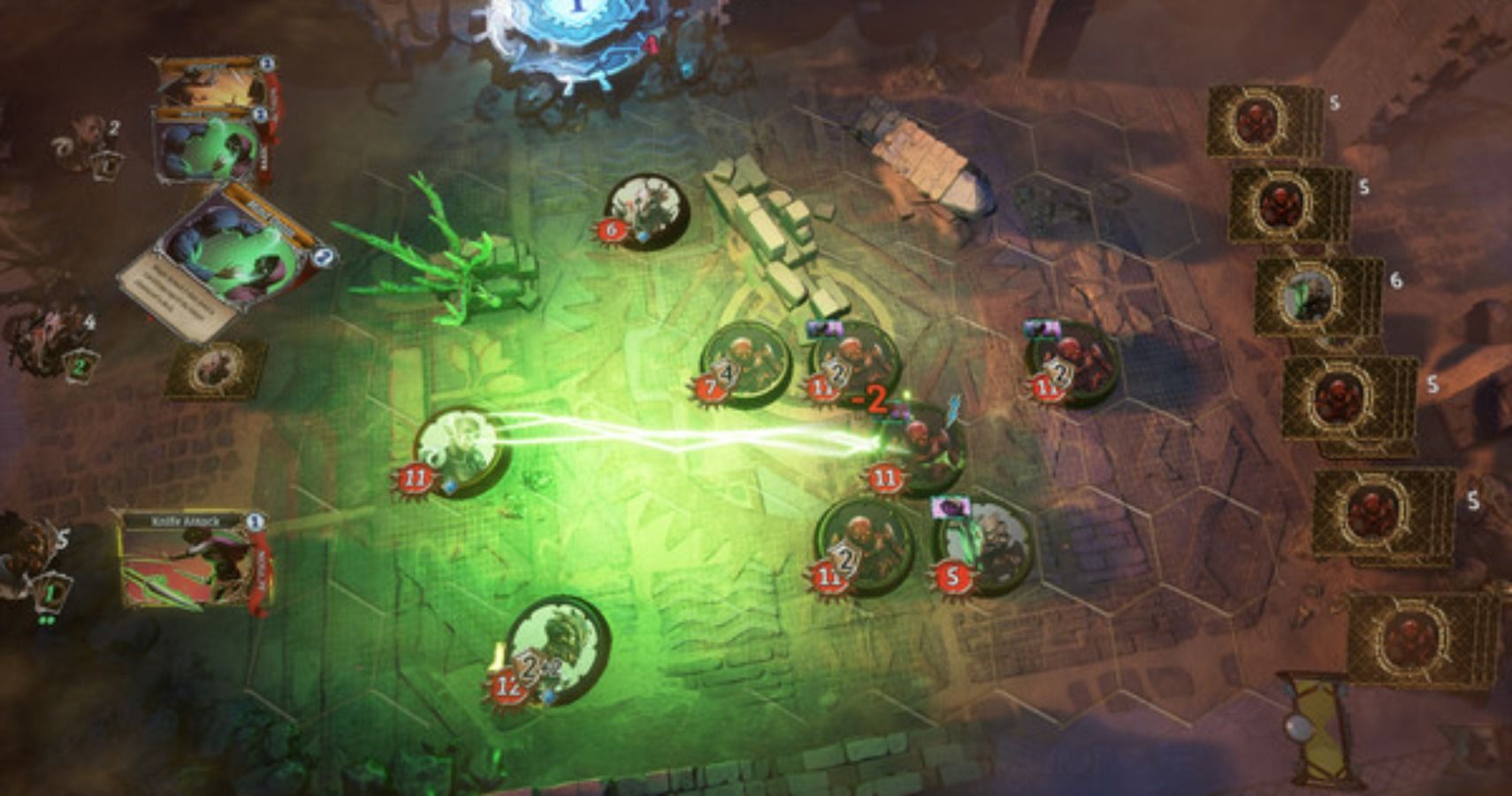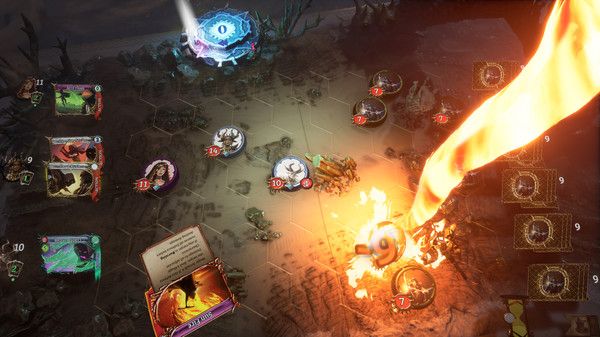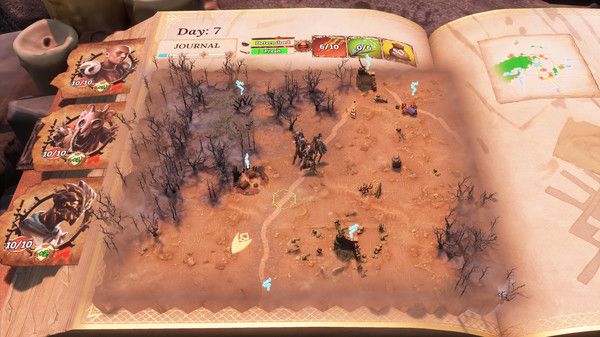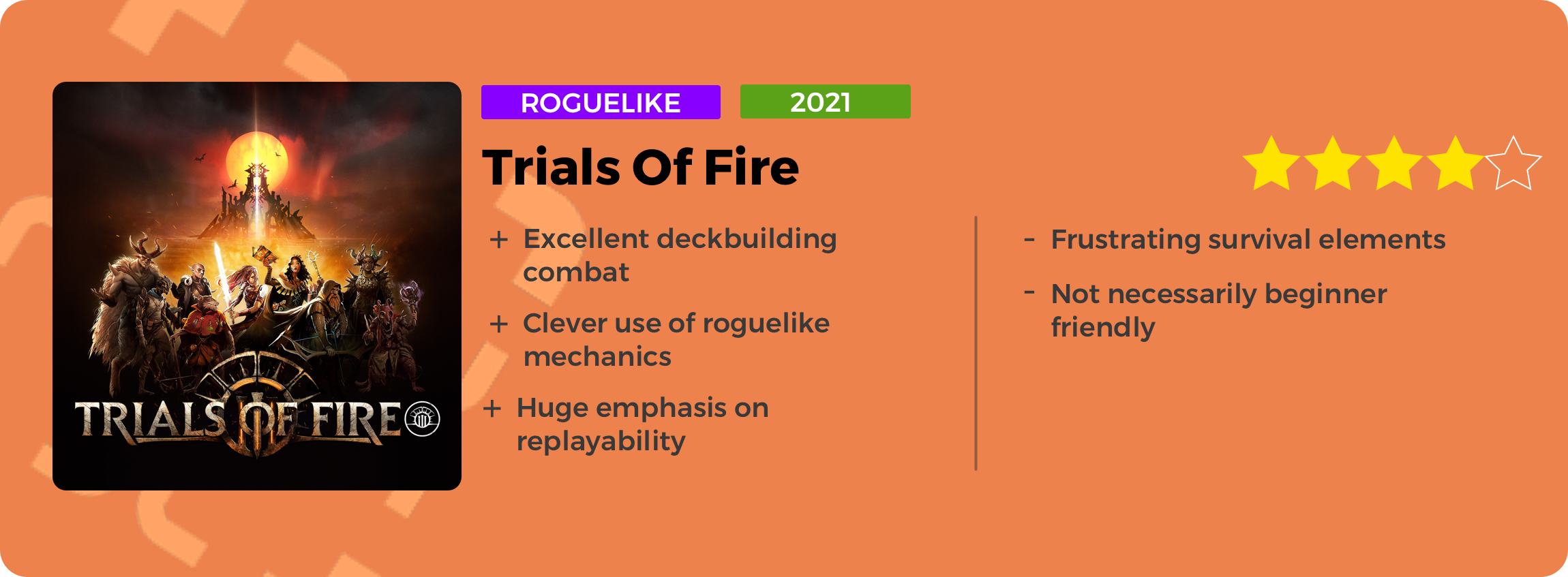I find myself praying that the rotten Ratling currently skulking across the hexagonal segments of a grid-based map loses its momentum. Being the benevolent soul that I am in this war-ravaged world, I decided to save a couple of innocents from the clutches of this band of nefarious rodents - although being the the impulsive idiot I am, I did so while my ragtag team of miscreants and misfits were both fatigued and suffering from near broken morale. This, combined with a lack of decent cards from my last draw, is perhaps why my previous move was decidedly less effective than that of this ostensibly weak but actually very sneaky Ratling.
While I inch towards the end of a prayer to no one, the Ratling uses its last drips of mana to traverse the map and swipe at my hunter, sending its mark to its maker as I am forced to recognize yet another spectacular defeat. This is Trials of Fire, a game that is, in fact, multiple games at once, all of them excellent in their own right.
That statement in and of itself may not seem extraordinary - that a game can simultaneously encompass several genres. Trials of Fire, however, takes this to a whole other level. It revolves around a band of three RPG companions, gradually traversing the storybook pages of a desolate world. These characters all have their own equipment, which initially appears to add to the RPG experience, but in fact determines the cards they carry because combat in Trials of Fire is tied to deckbuilding. And as with a variety of other contemporary deckbuilders, Trials of Fire also presents itself as a roguelike, where death means game over and each new beginning is similar yet radically different to the last one. That’s before we even mention its use of turn-based tactics, unforgiving survival elements, and every other classic video game genre function that tickles its fancy.
Admittedly, it seems a bit messy at first. There’s a lot going on, which makes the whole ordeal a little bit intimidating. I had no idea what I was doing for the entirety of my first run, and I didn’t fare much better during my second. There’s an almost daunting array of distinct cards on offer, most of which are dizzyingly compounded by progress, weapon, and armour-based add-ons. If you’re willing to give Trials of Fire the benefit of the doubt, however, the jigsaw will start falling into place in a refreshingly organic way. You’ll realize that you can’t save the humans from the Ratlings because there’s a boss below and you haven’t got enough resources to set up camp, heal your elementalist, and upgrade your warrior’s cards for increased damage output. So instead you decide to say “hello Ratlings” and trade with them as your fellow humans look on in horror and disgust. The Ratlings give you a pretty good deal, allowing you to stock up on waterskins and mystic herbs, when all of a sudden… bang! You’re beyond well-equipped for the boss battle below. That’s just one of Trials of Fire’s many beauties - you’ll soon realize that smart play doesn’t always equal, er… nice play.
Combat is excellent and intuitive for the most part, although I have some qualms. I’m a huge fan of deckbuilding roguelikes and have pumped dozens of hours into Slay the Spire and Monster Train. Trials of Fire puts an interesting twist on the formula by integrating turn-based tactics with grid traversal and distance-gated attacks, although it seems as if your opponent almost always has the upper hand. I did fairly well on Hard, although I eventually got fed up and turned it down to Easy in pursuit of a winning streak. To be honest, I noticed barely any difference between the modes, despite the fact there’s a whole other difficulty setting between them. I’m sure there are marked differences, of course, but it still felt as if the enemy had endless mana and brilliantly robotic area-of-effect strategies. It’s more akin to the difference between playing chess against Magnus Carlssen aged 11 and 12 than playing against enemies on a good roguelike player’s level and ones who give you at least an instance of elbow room per turn.
Still, combat is riveting. You’ve got so many options every turn - after each of your heroes draws three cards, you’re tasked with doling out willpower in accordance with a cohesive strategy. You can ditch cards for extra mana, move, attack, defend, and more. It’s difficult to visualize synergy at the beginning, but you learn both by making mistakes and watching your opponents succeed. When you pull off a solid play - say you ditch a total of four cards, use movement abilities to close in on an opponent in such a way that your warrior has enough mana to use their heroic card, while your hunter and elementalist are on adjacent spaces that trigger a combo mechanic - it feels incredible. I think these are the moments that kept and are keeping me coming back to this game, despite how frustrating it can be. When it clicks, it roars into action like an enormous generator fed oceans of petrol before smoothing out into a steady and healthy hum.
I’ve mentioned different kinds of characters a couple of times now, so I feel it’s probably worth saying that the reason I’m saying things like “hunter” and “elementalist” is because I never felt obliged to learn their names. You can rename them, mind, which would obviously accentuate your attachment to them, but in all honesty the narrative elements of Trials of Fire are more strictly functional than prosaically pretty. I would often refer to characters in terms of the cards they held as opposed to their names or class descriptions. I think one of my lads had his name automatically generated as “Rastin,” although it could have just as easily been Rasputin, Raskalnikoff, or Radagast.
Strangely, I think this is a major strength derived from a minor weakness. The writing across the board isn’t the most enthralling material, but it works to serve moment-to-moment play, which is what Trials of Fire is all about. It is, first and foremost, a game that is an absolute joy to play as opposed to an experience designed to be parsed and slowly considered. I think about strategy when I play Trials of Fire, and resource conservation, and the balance between straying off the beaten path for a side quest reward and venturing sufficiently far off-course for my companions’ morale to die, leading to a game over. Yes, this actually happens, and I was furious but oddly understanding every time it occurred to me. I didn’t like the camping elements much - it feels as if you need to go to bed every 30 seconds - although I can see why they’re there. It helps shape the objective of the game, causing you to carefully consider routes to your objective as opposed to tidying up every question mark on the map.
What helps all of this most of all is how contained each run is. They’re longer than a lot of other roguelikes - I’d expect to carve out at least 90 minutes for a successful medium-length run - but remember that Trials of Fire is also very aware of its RPG basis. The combination of these genres is its trump card, because even with characters written to represent typical classes and narrative components disguised as dilemmas to facilitate strict design functionality, Trials of Fire is an experience that is very difficult to pull yourself away from. I mean, it’s right there in the title, isn’t it? “Trials,” as opposed to “trial.” You’re probably an advocate of the old “once burned, twice shy” adage if you’re a particularly proverbial person, but the opposite is true here.
When you fail a Trial of Fire, you learn and you move on. The thing about this game is that every single run is better than the last one, even if it’s decidedly more short-lived. In fact, that’s actually a blessing in disguise - more time for another go before bed, eh?
Score: 4/5
Trials of Fire
A PC copy of Trials of Fire was provided to TheGamer.com for this review. Trials of Fire is available on PC.





